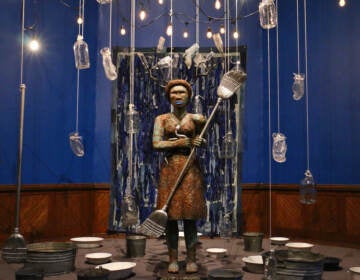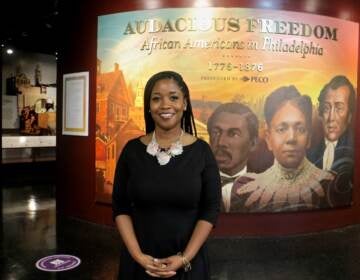‘Rendering Justice’ at African American Museum features formerly incarcerated artists
“Rendering Justice,” at the African American Museum of Philadelphia, features artists making work about reentering society.
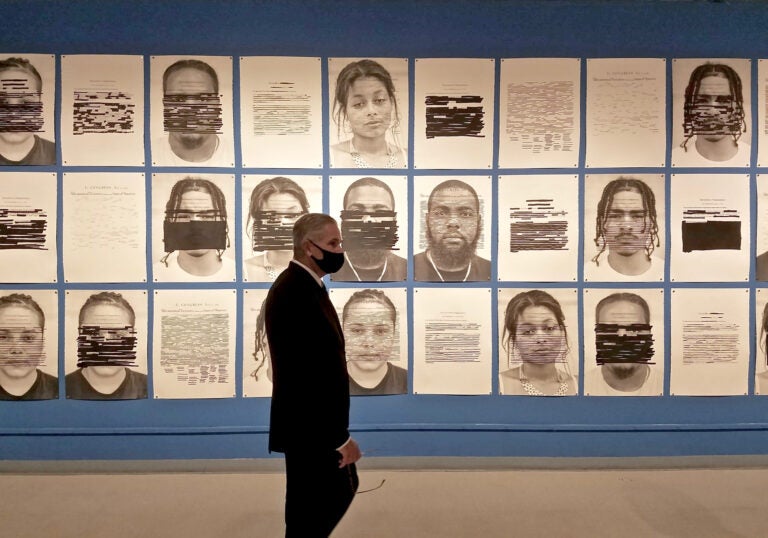
District Attorney Larry Krasner views 'Redaction,' a mural of portraits by Titus Kaphar and Reginald Dwayne Betts in the gallery of the African American Museum of Philadelphia.(Peter Crimmins/WHYY)
For its new exhibition, “Rendering Justice,” the African American Museum in Philadelphia hung a monumental-sized portrait on the front of its building. Artist Russel Craig created a canvas of recycled leather handbags stitched together as a patchwork of green and brown — the brass clasps are still visible — and painted on top the face of James “Yaya” Hough.
Hough was Craig’s artistic mentor when both were incarcerated in SCI Graterford, a state prison in Montgomery County. Hough approached Craig soon after he arrived at Graterford, when he saw that Craig was making art so often.
“I spent a lot of time trying to encourage guys getting into the arts,” said Hough. “I knew that in prison that was the most powerful salvaging force an individual could harness to change their lives and transform themselves.”
According to Craig, Hough made a prediction: Craig would someday find a successful life outside Graterford as an artist. Even more, in Hough’s vision of the future, he would be there with Craig.
“It was a positive conversation, and I didn’t doubt it,” said Craig. “The only part that was hard to take was when he talked about, ‘When I get out …’ I didn’t see how that was going to happen.”
Hough was sentenced as a juvenile to life in prison. At the time of that conversation, there was very little hope he would ever get out. Then, in 2012, the U.S. Supreme Court outlawed mandatory life sentences for juvenile offenders. In 2016, the court applied the ruling retroactively. In 2019, Hough was released.
Ultimately, Hough’s prediction came true: He is now wrapping up a yearlong stint as artist-in-residence with the District Attorney’s Office, and Craig is actively showing his work in many places while studying art at Bard College.
This week, Craig and Hough stood side-by-side in front of the African American Museum, looking up at the giant portrait one made to honor the other.
“The little narcissist in me likes it, but the humble person I strive to be every day says I’m nothing but a symbol of what’s possible in a positive way for people returning to society,” he said. “In that sense, I’m not unique.”
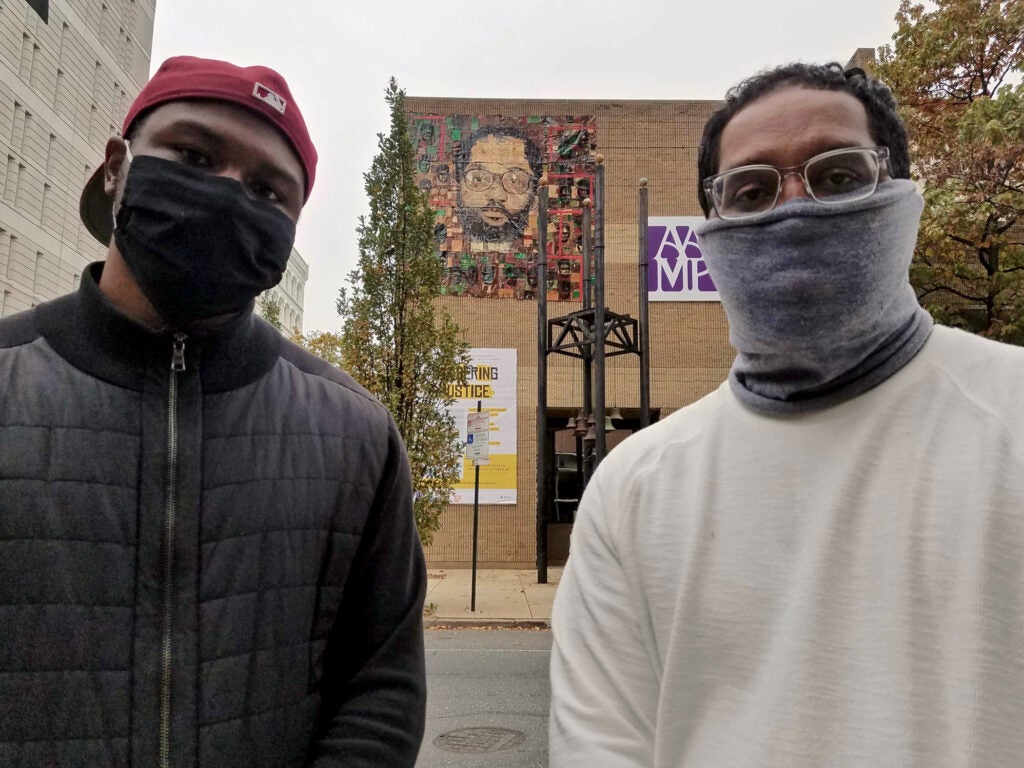
Though the portrait, “Prophesied,” adorns the African American Museum building, for now that’s as far as visitors will get: AAMP remains closed due to the COVID-19 pandemic.
The City of Philadelphia has allowed museums to reopen at limited capacity, but those limitations are too great for AAMP to effectively reopen. The museum anticipates welcoming visitors into the new exhibition at a later date, which is not yet determined. Until then, the show can be viewed as a virtual experience on the museum’s website.
“Although it was developed using much of the content in the show, we believe that the virtual experience is essentially different from the in-gallery experience,” vice president of programming Ivan Henderson wrote in an email. “[We] anticipate interacting with audiences around this exhibition in both forums when we do reopen.”
The exhibition features work by nine artists who are either formerly incarcerated or have been affected by the criminal justice system. It includes “Redaction,” a wall of portraits with each overlaid with text from the Declaration of Independence. Artist Titus Kaphar and poet Reginald Dwayne Betts asked each subject to redact, in thick black lines, as much of the historic text as they wished.
Photographer Deborah Willis took mug shot-style pictures of formerly incarcerated people but dropped her camera lens down below the face. We see only their hands and torsos, sharply dressed to reflect their successes in reentering society.
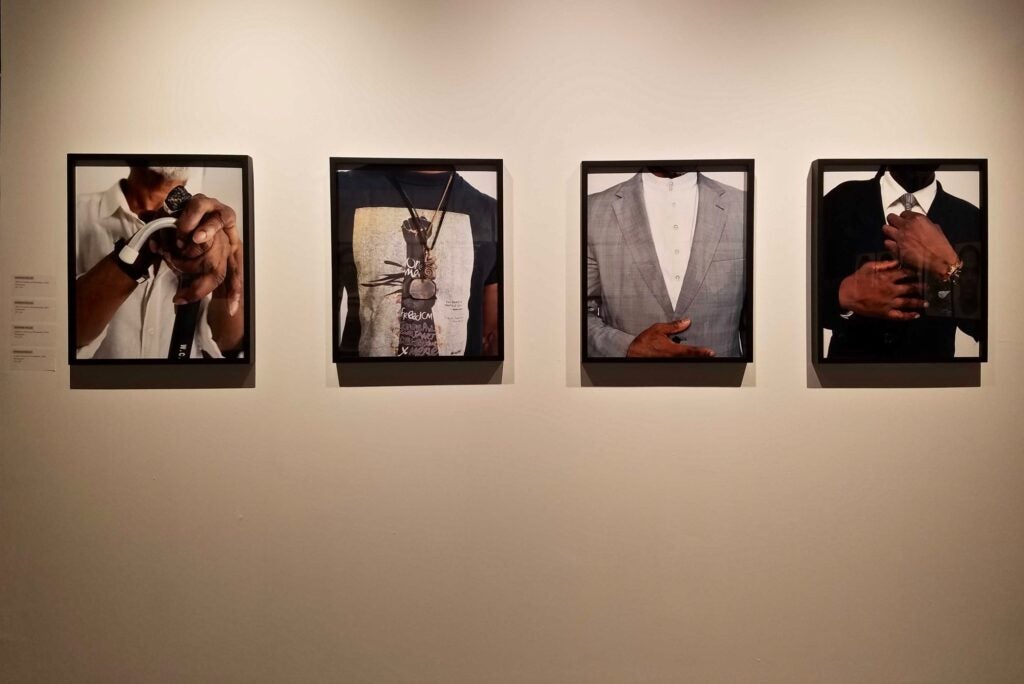
The show also includes the more abstract work of Jared Owens, who started painting while in federal detention. Owens also painted an outdoor mural associated with the exhibition, “PhilaGuernica” at 11th and Callowhill Streets, a take on Picasso’s famous “Guernica” painting, but with imagery reflecting iconic Philadelphia symbols.
Two other public murals, by Michelle Daniel and Deborah Willis, and by Titus Kaphar and Dwayne Betts, are forthcoming.
“Rendering Justice” is a collaboration between AAMP and Mural Arts Philadelphia, which for many years has been working with incarcerated and formerly incarcerated people on public art projects through its Restorative Justice program.
The exhibit was curated by one of the program’s success stories, Jesse Krimes, formerly incarcerated and now recognized nationally for his art. He organized the show to be a platform giving voice to those who are directly involved with the criminal justice system.
“When we’re talking about mass incarceration and we’re not talking to people who are directly impacted, that’s a problem,” said Krimes.
He was speaking at a podium outside the museum, on the sidewalk at 7th and Arch streets, where a small preview event was held. Among the attendees was Philadelphia District Attorney Larry Krasner. He pointed across the street to the Federal Detention Center, where he had spent much of his time during his former life as a defense attorney.
“It feels like a tomb. It feels like a morgue. They deliberately keep the temperature low. There are no windows to speak of. Everything is fairly robotic, which is not good even for the guards,” said Krasner. “It is not a good place for anybody.”
The fact that AAMP is across the street from a federal detention center is a fluke of real estate development, but the museum embraces that proximity when it wants to highlight how overrepresented Black people are in America’s mass incarceration system.
Krasner said he was “blown away” by the art inside the museum, for both the quality of the work and its perspective on criminal justice reform.
“This art is getting us to where we need to go,” said Krasner. “Where we need to go is a way for mass incarceration that not only shows the lie that we are currently the land of freedom, not only shows where we need to go is toward being the land of freedom, but also makes important comments about the completely unresolved issues of racism in the United States.”
“Rendering Justice” is in some ways a smaller version of the major, 44-artist show currently on view at the PS1 gallery of the Museum of Modern Art in New York, “Marking Time: Art in the age of mass incarceration.” Several artists appear in both shows.

Get daily updates from WHYY News!
WHYY is your source for fact-based, in-depth journalism and information. As a nonprofit organization, we rely on financial support from readers like you. Please give today.



